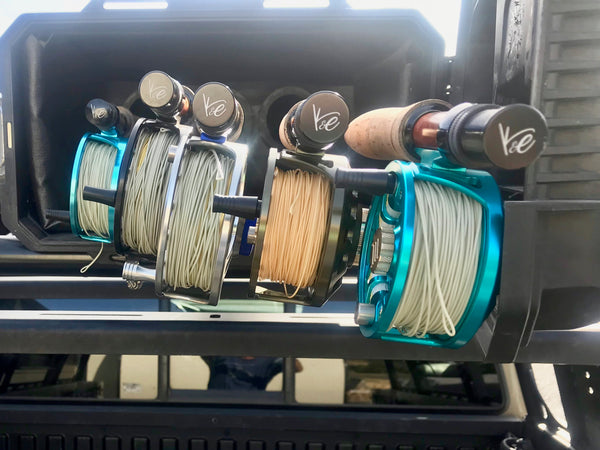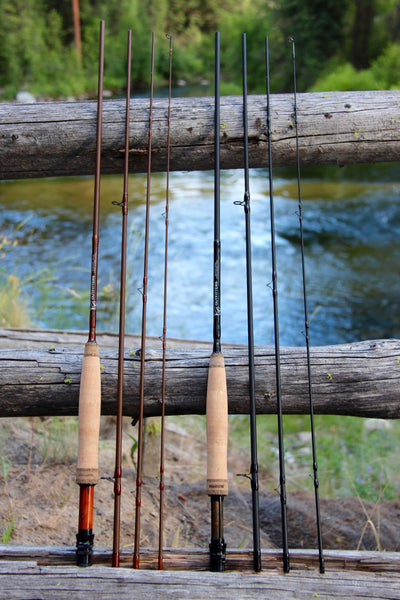What is a Fly Fishing Strip Set?

Strip! Strip! Strip! Set!
This is the song of the saltwater fly fishing guide and any fly angler that has cast a line off the bow of a flats boat or stripped streamers for big trout can tell you how this chant will automatically raise your heart rate by 20 beats per minute. But if you are new to fly fishing or maybe haven't yet ventured outside of the trout fly fishing world, you may be asking, "what is a strip set" and more importantly, "why do I need to use it". Here is our take on the differences in technique and purpose of the strip set versus the traditional trout set and when it is absolutely important to use it.
Let's first review the "trout set" so we can make the comparison.
The classic hook set in fly fishing is sometimes referred to as the trout set. The angler perceives that the fish has taken the fly and in response lifts the rod tip (sometimes combining this with a tug on the line with the stripping hand) to set the hook. The rod then bends under the weight of the fish and, well, fish on!
Typically, this technique for hook set in fly fishing is used for flies that are being dead drifted. These flies are usually imitating a small insect and the fish are feeding on these in a relatively gentle manner. The angle of attack by the trout is the key to why the trout set works. Insects are usually higher in the water columb than the trout resulting in a upward attack by the fish. Trout are wary and so once they have the fly in their mouth, they typically will turn and try return to the relative safety of deeper water. This results in the fish pointing down and the fishing line pointing up. By using a trout set, we are simply adding enough upward tension against the downward point fishes mouth to achieve a hook set. The trout set is a slower hook set than the strip set. It takes time to lift the rod, the rod to bend in response, the line on the water to come tight and lift, and the tension to be applied to the fly. But there is plenty of time (relatively) as it takes a moment for the trout to return to the deeper water and level off.
Also, the trout set is a gentle hook set but comparison to the strip set. There is less of a chance of ripping the fly out of the often delicate mouths of trout.
Now, lets compare to the strip set.
The strip set is more commonly used when fishing fly patterns that represent bait fish patterns or crustacean patterns. Basically, things that have the ability to swim or move in the water. Fish that are feeding on these organisms or take a fly presented in this way are behaving much more aggressively and have a different angle of attack.
When we strip underwater patterns back to the rod, the fly is "swimming" horizontally in the water column rather than drifting. The fish will usually attack the fly from the side or behind in that same (or very close to that same) level in the water. The angle of attack is more linear. As a result a trout set would change the angle of the fly abruptly in an upward manner and this is not an expected movement by the fish. On the other hand a strip set is linear, in the same direction as the original line of travel of the fly.
The fish expects the bait to make a run for it and is not surprised if their is a forward acceleration and clamps down on the fly in response. The problem for the fish is, we are applying longitudinal tension to that fly and the result is a good hook penetration into the lip. The strip is strong and will penetrate the hard mouths of predatory fish, the trout is will not.
Another benefit of the strip set is that an angler can repeat the hook set 2 or 3 times very quickly. Again, fish thinks the swimming bait is trying to get away and will stay clamped down sometimes for several seconds. If the first strip set isn't quite enough or if there was some slack line that needed to be pulled in before a strong connection could be made, then a second or third strip will get the job done. How often have you been able to trout set 2 or 3 times on the same fish....never.
Strip setting is also much faster. We are not trying to lift 30-50 ft. of line out of the water to achieve tension on the fish. Instead we are pulling it directly in line. Tension comes immediately and this is important when trying to hook fish that are heavy and moving quickly. Trout sets, while still fairly quick are lightyears too slow when compared to a strip set.
The guys at www.ginkandgasoline.com have a quick video that shows what a strip is:
We hope that helps define and describe the strip set some. There certainly are other factors that play into it and this is only a brief overview based on our experience and opinions. But one thing we know is this. The fastest way to miss a big predatory fish chasing down your streamer is to trout set when that line comes tight. And if you are with a guide, well, it might sound more like: Strip! Strip! Strip! Aaarrrgh!
Also in News

Unlocking the Secrets of Fly Rod Weights: A Comprehensive Guide
Fly Fishing Tapered Leader Size Chart
| 2X | 10.0 lb |
| 3X | 8.2 lb |
| 4X | 6.4 lb |
| 5X | 5.0 lb |
| 6X | 3.4 lb |


